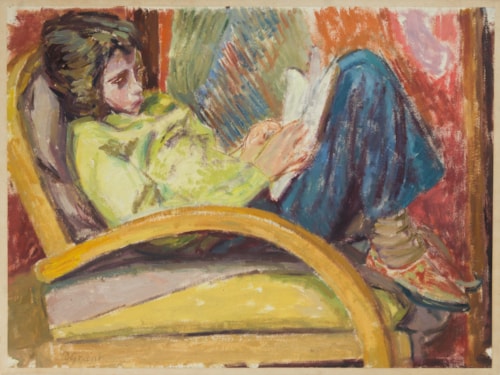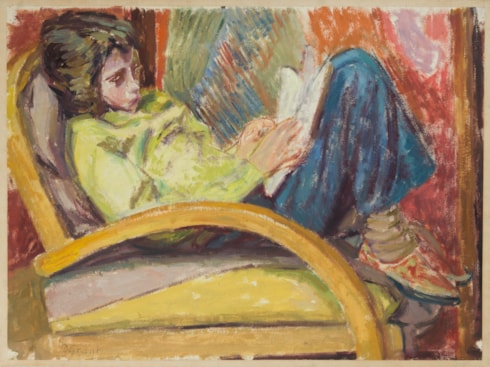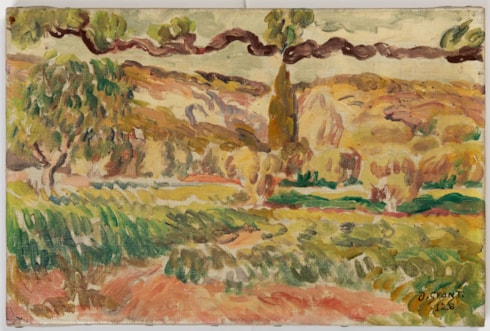
Duncan GRANT
Doune, nr. Aviemore 1885 - Aldermaston 1978
Biography
Born in the Highlands of Scotland, Duncan Grant was educated in London and manifested an interest in art from his youth. He was trained in Paris, studying for a period with the painter and draughtsman Simon Bussy, and found inspiration in the work of such Post-Impressionist artists as Cézanne, Gauguin and Van Gogh, whose paintings were championed in England by the art critic and artist Roger Fry. The art of the Parisian Post-Impressionist painters was to have a profound effect on the work of the young Grant. Through his cousin Lytton Strachey, Grant was introduced to Fry and the other artists and intellectuals of the Bloomsbury Group, notably Vanessa Bell and her husband, the art critic Clive Bell, as well as her sister, the writer Virginia Woolf. In October 1912 Grant showed several works at the Second Post-Impressionist Exhibition, organized by Fry at the Grafton Gallery in London, which aimed to show the work of modern British painters alongside that of European artists such as Picasso and Matisse. In 1913, Fry, Grant and Vanessa Bell established the Omega Workshops, a design collective, based in Bloomsbury in central London, that produced textiles, furniture, ceramics, murals and household goods for domestic interiors. In 1916, at the height of the First World War, Grant, his lover, the novelist David (‘Bunny’) Garnett, Vanessa Bell and her two young sons left London for the country, eventually settling at Charleston Farmhouse, near Firle in East Sussex. For much of the next half century this isolated house, which was extensively decorated by Grant and Bell, remained a rural outpost and meeting place for members of the Bloomsbury circle.
Lifelong artistic and emotional partners, Grant and Bell worked side by side and shared their lives until her death in 1961. The two were lovers for a brief period, despite Bell’s (by now failed) marriage and Grant’s homosexuality, and on Christmas Day 1918 their daughter Angelica was born at Charleston. (Raised by Clive and Vanessa Bell, she did not learn who her true father was until she was eighteen.) In February 1920 Grant had his first one-man exhibition at the Paterson-Carfax Gallery in London, with twenty-four of the thirty-one paintings finding buyers, while towards the end of that year a group of his watercolours were shown, alongside watercolours by Bell, at Percy Moore Turner’s newly opened Independent Gallery in London. Grant was to continue to show his work at the Independent Gallery over the next few years, achieving some commercial success, while working between studios in London, Charleston and Paris and continuing to receive commissions for interior decorations in private homes. In 1924 a small monograph on his work was published, with an introductory essay by Roger Fry, and the following year both Grant and Bell were among the artists invited to join the London Artist’s Association, established, at the suggestion of Fry, by John Maynard Keynes and the collector Samuel Courtauld. The inaugural London Artist’s Association exhibition, held at the Leicester Galleries in 1926, was a critical and commercial success, with Grant widely regarded by most critics as the most gifted member of the group. Within a few years Grant’s paintings – landscapes, portraits, still life subjects and interior scenes, for the most part - were being shown at other galleries in London, as well as in America, France and Germany.
Grant and Bell continued to work often alongside each other, both in England and in France, and also travelled, together and with friends, throughout much of Europe. The pair collaborated on a number of interior decorations, most significantly the dining room of the country home of Lady Dorothy Wellesley at Withyham in Sussex, begun in 1928 and completed between 1929 and 1931. (Much praised at the time, the painted panels are today in the Southampton City Art Gallery.) In 1931 both Bell and Grant left the London Artist’s Association and signed contracts to sell their work through the Agnews and Lefevre galleries in London, and between 1932 and 1934 they collaborated on a fifty-piece dinner service decorated with portraits of famous women, a commission from the art historian and museum curator Kenneth Clark, who was a prominent supporter and collector of their work. In 1935 Grant was one of several prominent artists tasked with providing works of art for the ocean liner RMS Queen Mary, then being built at Clydebank in Scotland. Despite spending about a year designing and painting several large murals, carpets and curtains intended for the first-class lounge, his work was rejected by the directors of the Cunard-White Star Line and was never installed. Grant and Bell also worked together, alongside Bell’s son Quentin, on the extensive mural decoration of the small rural church at Berwick, a few miles from Charleston, which was completed in 1943. The early years of the postwar period found Grant at the height of his success. Later public commissions included the decoration of the Russell Chantry of Lincoln Cathedral, completed in 1958. The following year a retrospective exhibition of Grant’s work was mounted at the Tate Gallery, which included eighty-four paintings and fifty-three drawings and watercolours. After Vanessa Bell’s death in 1961, Grant continued to live and work at Charleston until his own death in 1978. The two painters are buried next to each other in the nearby churchyard of St. Peter’s Church in West Firle.



